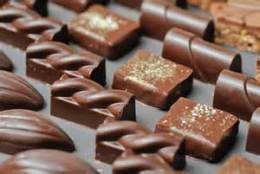What do ham, chocolates and bayonets have in common? The answer is the city of Bayonne, France. Bayonne, known as Baïona in Basque, is situated in Basque Country on the French side of the Pyrenees. Half-timbered houses with green and red trim, the colors of the Basque flag, augment the feeling that you are in Basque territory. In fact, the city was a center of the Basque separatist movement. Indeed, graffiti expressing a separationist desire in the locals can still be seen. The French government has all but stamped out dangerous tendencies towards nationalism.
Chocolate Bayonne is celebrated as the chocolate capital of France. Ex iled Sephardic Jews brought chocolate to Bayonne and helped to introduce the chocolate industry into France. Chocolate boutiques abound in Bayonne, each with its own specialties.
iled Sephardic Jews brought chocolate to Bayonne and helped to introduce the chocolate industry into France. Chocolate boutiques abound in Bayonne, each with its own specialties.
Ham Bayonne is synonymous with ham. The famous jambon de Bayonne even has a protected appellation. To make true jambon de Bayonne, fresh hams are rubbed and covered with salt from the Adour River Basin, then put into a salting-tub. After several days they are washed to remove the excess salt. Finally, the hams are hung in a curing room, where they lose some of their weight and slowly dry—it takes from nine to twelve months to cure a Bayonne ham. Local air and wind play an important  role in the flavor of the hams during the curing process. To verify the authenticity of a ham, look for the Lauburu, the Basque cross, branded on the rind with a hot iron.
role in the flavor of the hams during the curing process. To verify the authenticity of a ham, look for the Lauburu, the Basque cross, branded on the rind with a hot iron.
Bayonets Bayonne was the center of cutlery manufacturing in the 16th century. An armaments industry developed in the city, giving the world the “baïonnette” (bayonet). The exact origin of the knife is not clear. Some claim the bayonet was developed in 1640 on rue des Faures (Blacksmiths’ Street). Others claim Bayonne peasants engaged in a military conflict ran out of powder and shot, and rammed their long-bladed hunting knives into the muzzles of their primitive muskets to fashion impromptu spears. Whatever the claims, Bayonne is always at the center.
In my novel, “Murder on the Seine,” I explore the remnants of the separatist movement and my characters dine on jambon de Bayonne.
More Tips:
Where is Sare, France that is?
Le Pont Neuf: Setting for a New Murder Mystery
Basque Country: The people and Culture











Leave a comment